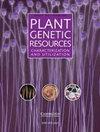Identification of potential donors for false smut resistance in elite breeding lines of rice (Oryza sativa L.) under field conditions
IF 0.7
4区 生物学
Q3 PLANT SCIENCES
Plant Genetic Resources: Characterization and Utilization
Pub Date : 2022-05-04
DOI:10.1017/s1479262122000041
引用次数: 0
Abstract
False smut of rice is an emerging disease and caused severe damage to hybrids and inbred rice cultivars grown in Asian countries. The objective of the study was to quantify of false smut resistance and identification of donors in some of the advanced breeding lines and rice varieties developed at Punjab Agricultural University, Ludhiana, India. A total of 31 genotypes were evaluated for three years in two planting date per year under field conditions. The lines were categorized into short, medium and long durations based on days to flowering. False smut was quantified using different disease variables such as per cent infected panicle, number of false smut ball per plant and disease score. Disease variables were significantly and positively correlated to each other. The infected panicle ranged 0.0–75.4% was observed among the genotypes. Three advanced lines namely RGS-2 (short), RGM-3 (medium) and RGL-3 (long) showed the lowest ranged 0.0–4.9% of infected panicle as compared to susceptible checks (47.7–75.4%). The genotypes were divided into five groups according to a component of resistance. The third group had the lowest average values (3.3%) of infected panicle as compared to the fifth group with the highest values (36.2%) of the infected panicle. The overall trend of disease variables was higher in short duration genotypes as compared to medium and long durations. Weather factors such as rain fall, rainy days and high relative humidity during the flowering period were favourable for disease development. The genotypes with lower disease variables could be utilized in diseases resistance breeding programme.稻田条件下水稻优良选育品系抗假黑穗病潜在供体的鉴定
水稻稻曲病是一种新兴病害,对亚洲国家的杂交和自交系水稻造成严重危害。这项研究的目的是量化在印度卢迪亚纳旁遮普省农业大学开发的一些高级育种品系和水稻品种的假黑穗病抗性和供体的鉴定。在田间条件下,每年两次播种,共对31个基因型进行了3年的评价。根据花期分为短、中、长三种。利用不同的疾病变量,如感染穗的百分比、每株假黑穗病球的数量和疾病评分,对假黑穗病进行了量化。各疾病变量之间呈显著正相关。侵染穗数在基因型中占0 ~ 75.4%。3个高级品系RGS-2(短)、RGM-3(中)和RGL-3(长)的感染穗率最低,为0.09% ~ 4.9%,低于敏感品系(47.7% ~ 75.4%)。根据抗性成分将基因型分为5组。第3组平均侵染穗数最低(3.3%),第5组最高(36.2%)。与中长期基因型相比,短期基因型中疾病变量的总体趋势更高。花期降雨、多雨、相对湿度高等天气因素有利于病害的发生。具有较低病变的基因型可用于抗病育种。
本文章由计算机程序翻译,如有差异,请以英文原文为准。
求助全文
约1分钟内获得全文
求助全文
来源期刊

Plant Genetic Resources: Characterization and Utilization
Agricultural and Biological Sciences-Agronomy and Crop Science
CiteScore
2.80
自引率
0.00%
发文量
29
审稿时长
>12 weeks
期刊介绍:
Plant Genetic Resources is an international journal which provides a forum for describing the application of novel genomic technologies, as well as their integration with established techniques, towards the understanding of the genetic variation captured in both in situ and ex situ collections of crop and non-crop plants; and for the airing of wider issues relevant to plant germplasm conservation and utilisation. We particularly welcome multi-disciplinary approaches that incorporate both a technical and a socio-economic focus. Technical aspects can cover developments in technologies of potential or demonstrated relevance to the analysis of variation and diversity at the phenotypic and genotypic levels.
 求助内容:
求助内容: 应助结果提醒方式:
应助结果提醒方式:


